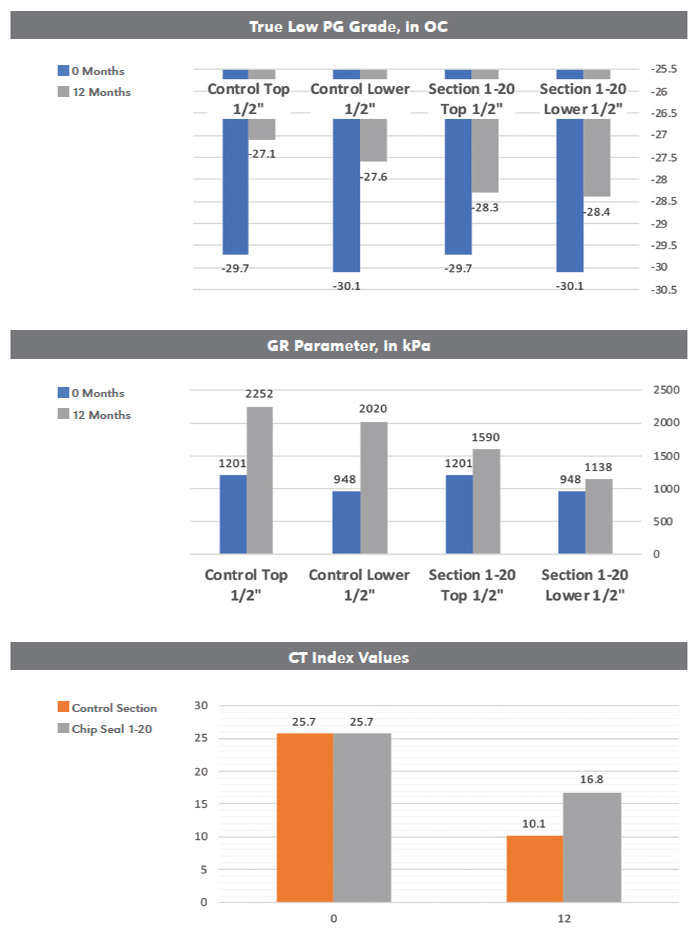As asphalt pavements age, the asphalt binder that glues the aggregates together oxidizes, making the pavements more brittle and susceptible to cracking and other deterioration. To help mitigate this process, many agencies will apply preventive maintenance products such as chip seals.
Most agencies, for various reasons, wait to place their chip seals until the onset of cracking or some other deterioration. However, the states of Montana, North Dakota and South Dakota typically place their chip seals within one year from the time of pavement construction.
If someone puts new cedar siding on their home, would they wait until it starts to rot before staining it? The answer is no.
We began a study to look at the benefits (life extension or the postponement of the onset of cracking) achieved through the early application of a chip seal on a newly constructed pavement. The application of a chip seal very early in the pavement’s life should help to preserve the quality of the binder in the pavement and should reduce the environmental aging (hardening) of the binder and ultimately improve crack resistance. A similar study was conducted in Minnesota and the results imply that to mitigate or slow the damage from environmental aging, sealing should occur within the first two years of the pavement’s life.
NYSDOT Route 11, just north of Homer, New York was selected as the test site for the study. Suit-Kote constructed this section of roadway beginning in 2019 with 3-4 inches of cold in-place recycling followed by a hot mix asphalt scratch course of ¾ – 1” to get the pavement through the winter. In 2020 they placed a 1 ½” wearing course of 9.5 mm hot mix asphalt using a PG 64V-22 polymer modified binder. Three weeks later, a chip seal was placed on a 1,000 ft. section of this new pavement with subsequent sections to be sealed in future years.
Cores have been and will continue to be taken annually from each of the sections for testing. Sections 1-20 and 2-21 have been sealed with cores taken from only the control section and section 1-20. Recovered binder testing, as well as mixture testing for this study, will continue at the Asphalt Institute lab in Lexington, Kentucky.

Once the chip seal material has been removed from the cores, mix slices are taken with the binder recovered from the top ½” and the next ½” of the cores. The recovered binder is tested for low-temperature stiffness (S) and relaxation (m) using the bending beam rheometer (BBR) and the critical temperature where m equals 0.300 and S equals 300 MPa is determined. The true low-temperature PG grades of the recovered binder collected to date are shown below. The dynamic shear rheometer is also being used to measure the Glover-Rowe parameter (GR). As the binder ages, the low-temperature grade and the Glover Rowe parameter both increase indicating that the binder becomes more brittle or stiffer. Mix testing to determine the cracking potential of the mixture is also being done on the top 1 ½” (wearing course) using the indirect tensile test to determine the CT (Cracking Tolerance) index value. As the mixture ages and the binder becomes more brittle, the CT index values should drop.
Test results from each section shown are leading to similar conclusions as those found in the Minnesota study in that early sealing of the pavement appears to greatly slow the rate of hardening of the binder in the mix. Looking at the top ½” of pavement during the first 12 months, the unsealed control section experienced a GR increase of around 88 percent while the chip sealed section 1-20 increased by just 32 percent. The low-temperature grade increased by 2.6°C for the control section and only 1.4°C for the sealed section. Binder recovered from the lower ½” of pavement for each section also exhibited increases in both low GR parameter as well as low PG temperature. Mix testing showed similar results with the CT index values falling by 15.6 and 8.9 for the control section and the sealed section respectively.
While these are preliminary results, they clearly show a trend that early preventative maintenance will extend pavement life. Plans are to continue with this study with more sections to be sealed and cores to be taken annually until cracking appears on the roadway.
Harder is an Asphalt Institute Senior Regional Engineer based in New York.














